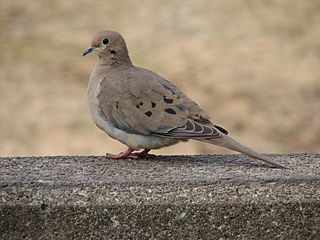
The Leptotyphlopidae are a family of snakes found in North America, South America, Africa and Asia. All are fossorial and adapted to burrowing, feeding on ants and termites. Two subfamilies are recognized.

The zenaida doves make up a small genus (Zenaida) of American doves in the family Columbidae.
Antoine Alphonse Guichenot was a French zoologist who taught, researched, and participated in specimen collecting trips on behalf of the Muséum national d'histoire naturelle (Paris), including an extensive biological survey of Algeria.

Bipalium is a genus of large predatory land planarians. They are often loosely called "hammerhead worms" or "broadhead planarians" because of the distinctive shape of their head region. Land planarians are unique in that they possess a "creeping sole", a highly ciliated region on the ventral epidermis that helps them to creep over the substrate. Native to Asia, several species are invasive to the United States, Canada, and Europe. Some studies have begun the investigation of the evolutionary ecology of these invasive planarians.

Pyrgilauda is a genus of passerine birds in the sparrow family Passeridae. They are found in the Himalayas, Tibet and western China.
Fulcinini is an Australian praying mantis tribe in the subfamily Fulciniinae.
The Reptile Database is a scientific database that collects taxonomic information on all living reptile species. The database focuses on species and has entries for all currently recognized ~14,000 species and their subspecies, although there is usually a lag time of up to a few months before newly described species become available online. The database collects scientific and common names, synonyms, literature references, distribution information, type information, etymology, and other taxonomically relevant information.

Eupsittula is a genus of South and Middle American parakeets in the tribe Arini. Until 2013, all the species were believed to belong to the genus Aratinga. Some of the Eupsittula species are kept in aviculture or as companion parrots, where they are commonly known as conures.

iNaturalist is an American 501(c)(3) nonprofit social network of naturalists, citizen scientists, and biologists built on the concept of mapping and sharing observations of biodiversity across the globe. iNaturalist may be accessed via its website or from its mobile applications. iNaturalist includes an automated species identification tool, and users further assist each other in identifying organisms from photographs. As of 9 July 2024, iNaturalist users had contributed approximately 197,660,888 observations of plants, animals, fungi, and other organisms worldwide, and 290,007 users were active in the previous 30 days.
Crosbycus is a potentially monotypic genus of harvestmen in the family Taracidae, with one species found in North America as of 2023, per the World Catalog of Opiliones.

Taracidae is a family of harvestmen in the order Opiliones. There are 4 genera and 23 described species in Taracidae.
Cladolasma, is a genus of harvestmen belonging to the family Nemastomatidae. The genus is monotypic containing a single species Cladolasma parvulum. They are endemic to Japan, with records in Ehime and Tokushima Prefectures. The genus was described by Seisho Suzuki, with the type species Cladolasma parvulum Suzuki, 1963, subsequently revised to Dendrolasma parvulum in Suzuki (1974), but later restored as a valid genus.

Dendrolasma is a genus of harvestmen in the family Nemastomatidae with two described species. Both species are found in the western coast of North America. An overview of their taxonomy was provided by Schönhofer (2013).
Aleksandr Nikolaevich Bartenev was a zoologist, professor, Doctor of Biological Sciences, and Rector of Rostov University in 1920–1921. He was active in the Russian Empire and later the Soviet Union.

Parisopalpus is a genus of false blister beetles in the family Oedemeridae. The genus was first identified by Logan Hudson in 1975, who separated the group from Sessinia due to the presence of bifid mandibles, and n males of the species visible genitalia.
Martensolasma is a genus of harvestmen in the family Nemastomatidae with two described species . Both species are found in Mexico. The type species was include in catalog by Schönhofer (2013). The genus Martensolasma was described by William Shear, with the type species Martensolasma jocheni Shear, 2006. A second species was later added to the genus by Cruz-López, 2017.








